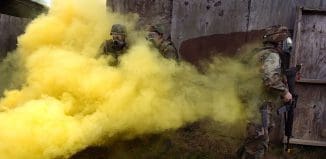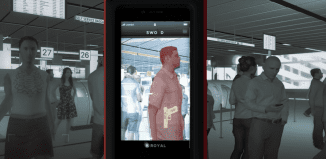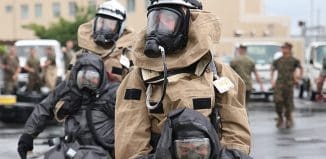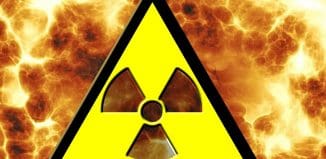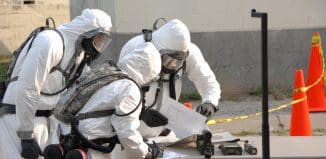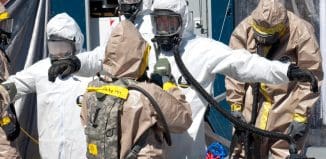- home
- News
- Technology
- Cyber
- HLS
- Innovation
- Unmanned
- Video
- Events
- Accelerators
- עברית
- Subscribe
- Contact Us
- home
- News
- Technology
- Cyber
- HLS
- Innovation
- Unmanned
- Video
- Events
- Accelerators
- עברית
- Subscribe
- Contact Us
Chemical Weapons
Multi-Purpose UGV Available For Variety of Missions
A mini, multi-purposed UGV has been designed and is ready for use by armed forces, police forces, and fire fighting forces around the world.
Designed...
How New Toxic Gases Detector Will Save Many Lives
Chemical weapons used to be very prevalent years ago and are still pretty common today. They are extremely deadly and can cause a substantial...
New Program Detects Chemical Threats
The Defense Advanced Research Projects Agency (DARPA) is now testing new chemical sensors that can assist easily detecting nuclear, biological, chemical, radioactive, and explosive...
Unexpected Measure Against Chemical Threats
Drone technology will have an important role in the UK’s defenses against chemical weapon attacks. Defense secretary Gavin Williamson has announced an £11m plan...
New Detection Device that “Tastes” Liquid Chemical Agents
A new chemical agent detector is developed by the U.S Army as a response to the challenges of site exploitation - the collection of...
New Device Challenges Terrorists
Asymmetric warfare, meaning conventional militaries combatting guerrilla and terrorist organizations, has long posed a challenge for states. New technology combining mobile platforms with the...
Drones and Exoskeletons Roam the Streets of Montreal
Drones, internet-connected vests and exoskeletons were put to test on the streets of Montreal. 150 unarmed soldiers and more than 100 researchers participated in...
Australia Enhances its Defense in CBRN Field
Australia is equipping its armed forces with new chemical, biological, radiological and nuclear defense capabilities. The defense ministry signed contracts worth A$238 million with...
IAI Collaborates on Robotic System Project for High-Risk Areas
Israel Aerospace Industries (IAI) has signed a collaboration agreement with DOK-ING from Croatia on the manufacturing, marketing and sales of a robotic system to...
Unexpected Technique to Detect Chemical Warfare Agents
Offering an innovative, low-cost and rapid means of threat agent detection, a new sensing technique may offer significant advantages for deployed warfighters. Researchers from...
Egozi: Israel’s Home Front is Not Prepared
By Arie Egozi
In recent years, we have been repeatedly warning here that the Israeli home front is not prepared for an emergency. But in...
Double-Eyed Drone – New Technology
DJI has teamed up with thermal imaging specialists FLIR to launch a new two-lensed camera system. The double-eyed drone enables drones to break new ground...
Simulation Systems Are Enhancing Military and HLS Agencies Readiness
Training and simulation systems have been an integral part of military and homeland security operations. The application of new technologies in this field can...
Future Forces to Use Compact Ring for Chemical Threat Detection
The demand for compact, lightweight and portable sensors having the capacity to connect to smartphones and laptops or computers is increasing. Among these are...
DARPA Funding New Portable Biological Weapons Diagnostics Device
Today’s battlefield can be a very unpredictable place, with threats coming from every direction, including from the air and from underground. Recent conflicts in...
New Anti Terror Super Unit Formed in UK
Britain has suffered quite a few terror attacks, mainly be Islamist Groups, with one to note is the London Underground attack in 2005. Now,...
Stand-Off Detection of Explosives Traces Under Development
Approaching suspected materials in order to check them is not always possible without risk. A new technology for the stand-off detection of trace quantities...
US Steps Up Measures Against Nuclear Terrorism
Intelligence analysis shows terrorist groups are actively pursuing Weapons of Mass Destruction (WMD) capabilities, are using battlefield environments to test them, and may be...
Plant-Based Sensors to Collect Intelligence
The US Department of Defense evaluates that the military’s traditional intelligence sensors are not always optimal for the tasks that have become more and...
Israel Unprepared for Drone Threats, US is Also Concerned
A report by Israel’s State Comptroller published yesterday, November 15th, reflects unpreparedness and considerable shortcomings regarding drone threats in Israel. The reports refers to...
New Measures, Old Problems
The possibility of a chemical attack in a central urban venue has accelerated US Department of Homeland Security (DHS) efforts to develop more security...
First-of-Its-Kind Wearable Chemical Sensor
Wearable electronics will be a $34 billion industry by 2020, according to analyst firm CCS Insight. Wearable sensors are capable of tracking processes in...
Latest
Copyright © 2012 i-HLS. All Rights Reserved.



